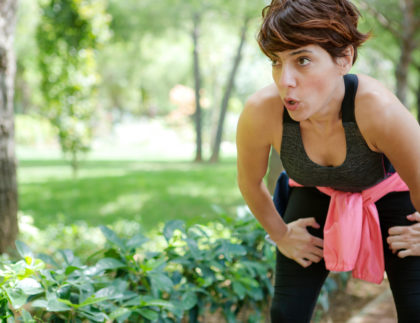The fall season is here and that means the kids are heading back to school. That also means it’s time to hit the store for new school supplies and backpacks! To help prevent your child from experiencing back pain from his or her backpack, follow these simple steps (video below)
Purchase a backpack that fits your child
A backpack should fit in the space between the cervical (neck) and lumbar (lower back) spine. Essentially, this is where the thoracic spine and ribcage are located. The shoulder straps should be wide or narrow enough to fit in the middle of the shoulder (not on the tip). Additionally, the backpack should be adjustable to allow your child to grow
Don’t load a backpack with more than 10% of body weight
A backpack should never be filled with weight greater than 10 % of your child’s weight. For example, if your child weighs 70 pounds, the backpack should not be heavier than 7 pounds! Many times, kids can over fill backpacks with books, binders, and other school supplies. Make sure the essentials are in the backpack, as to prevent back pain or poor posture routines.
Educate your child on how to wear a backpack properly
The backpack should sit just above the hips and buttock area and snug against the middle back. Show your child how the backpack should sit, and teach them how to adjust the straps. Some backpacks also have a waist strap. This strap is designed to fit snuggly over the hips and NOT the waist. This strap is meant to help decrease loads on the lumbar spine.
Encourage good posture all the time!
If you notice your child is walking with bad posture or carrying too much, remind them not to! Reinforcing good posture habits is the first step to preventing lower back pain. If your child does start to report pain in his or her back, contact a physical therapist to assess your child. They can help determine if further tests or healthcare professionals should be involved. Often times, fixing posture and strengthening muscles is the key to reducing your child’s back pain.

There is an old Chinese adage that proclaims, “Where there is movement, there is life!” But for most of the average American population, this invocation to move functions as more of a tease than it does an incentive. Many office professions have tethered their employees to the confines of a narrow cubicle, while other more physically laborious occupations push their employees to a level of movement and activity that is bound by complete exhaustion. Both of these extremes are injurious, both are marked by significant levels of stress, and both can truly benefit from the one constant, and omnipresent “exercise” of breath training.
As the conscious ambassador between the higher and lower levels of the nervous system, breathing, itself, is the quintessential exercise to remove stress, reduce pain, and restore health and healing. If there is life in movement, then there is illness and ultimately death in stagnation. Therefore, the extent and severity of all injury, be it from either external or internal sources, is dependent upon the mind’s ability to hold and retain tension, or “lack of movement,” within the confines of the physical body. More specifically, this sequence of “tension-retention” is called pain. Even more specifically, it is called “pain that you care about.”
Considering the gamut of life roles we participate in throughout our daily routine, how do we move without tension? Or, for those of the more sedentary obligation, how do we move… without moving?

Obviously, the answer is in the way we breathe. If there is no breath (aka internal movement), there is no animation to the body– no life! This is not just obvious, this is instinct. So therefore, as you breathe guide your breath throughout your body. Pay special attention to the areas where stress most readily harbors, where injury retains your pain. Don’t confine the flow of “air” to the anatomical boundaries of the throat, chest and lungs, but instead breathe through these regions and restore them. Whether your personal bias is to label the intangible movement here as air, energy, Qi, psycho-somatic awareness, or just plain “imagination,” your body will still reap the benefits of this transformative work with or without the appropriate choice of vocabulary word.
The physical mechanics of breathing with exercise should actually resemble the pendular sway of a clock or the ebb and flow of the tide, where there is perfectly uniform movement in both directions. The inhale and the exhale should be of equal volumes of air, with only the tiniest of pauses during the transition state from one cycle to the next. It is especially important not to get fixated on the idea of a “perfect” breathing pattern while exercising, since most functional activities will never mirror the ideal training circumstances of your gym or home living room. Instead, breathe continuously and learn to manipulate the flow and speed of your breath to create strength or softness as you see fit.

I can tell you from personal experience, the most important consideration when beginning to undertake any breath-work routine is not to obsess over it. Breath training at its most fundamental level is meant to be restorative and rejuvenating. It is important to relax and be natural and fluid, leading the air in through your nose and out through your mouth. If it looks like you’re trying to “do something” then you are doing something wrong, that is, with too much effort. Many times a quick, full inhale followed by a hard, pursed exhale is enough to “reset the system” before beginning breath-work again.
The first, and ultimately only one, real, true rule about breathing is to NOT STOP breathing. By adhering to the multiplicity of variations within this broad directive and the few aforementioned caveats, you will find a colorful way to reinvent your exercise program and invigorate your work life.

(Part 3 – Breathing Exercises – Next Month)
Almost nothing is ever counseled on the subject of breathing at either the beginning or advanced levels of training. Occasionally one will receive the obligatory disclaimer, “Exhale while lifting,” or “Don’t hold your breath!” Most clients typically show an understandable level of annoyance when instructed to “breathe,” with objections invariably following. “If I wasn’t breathing I’d be dead,” they’d say, or, “My body knows how to breathe. I’ve been doing it since I was born.” Of course, the body itself knows how to breathe, when it’s left purely to its own devices; it’s the mind that always gets in the way!
A rare, personal aside…
In the Fall of 2014 I underwent elective double jaw surgery, or radical maxillofacial reconstruction, to correct a progressive and disabling malocclusion of my lower jaw. The details are rather gruesomely unbecoming, but after a 7 ½ hour operation, at the hands of an extraordinarily skilled surgeon, my mouth was fitted with a plastic guard and wired completely shut. Breathing through my nose was impossible, as blood leakage had coagulated and sealed my sinuses shut. On top of that, my lower face was swelling rapidly under the pressure of a massive hematoma, and my respiration was slowing down as a side-effect of the opiate pain-killers. To put it bluntly, this was a breathing catastrophe with no escape!

As panic set in, I begged the doctors to cut open the surgical wires and free my only airway. But, when they checked my oxygen saturation it was near perfect, 99%; I was fine… supposedly. The surgical precautions would not be abandoned just to satiate the intense anxieties of my mind. Therefore, two possible outcomes could ultimately restore my breathing to a baseline, “survivable” state: 1) a quick shot of the anti-anxiety drug Valium; or 2) a complete nervous-system collapse, where I pass out and begin to breathe involuntarily through the tiny spaces at the base of my teeth. In the end, it was something between a little of both that pushed me through the night and into day 2 of recovery.
The important point of this horrific story has been somewhat over simplified in order to highlight the powerful, utterly devastating, effect the sympathetic nervous system has over one’s internal state. The mediator between controlling the stress of the ordinary and the panic of extraordinary is the breath. In fact, it is one of the very few autonomic, and involuntary, functions of the body that can be directly, and voluntarily, manipulated. Breathing is the de facto liaison between the conscious and subconscious levels. How essential it is, therefore, that it is incorporated into the proper training regimen!
It seems women have a marginally better handle on the rudiments of proper breathing. Maybe it’s more intrinsic or maternal, but in general the gross majority of the training population are subliminal breath-holders. This is not the “pinching-of-the-nose-while-jumping-from-the-deep end” type of breath holding, typically practiced in the isolation ward of a psychiatric hospital. These commonplace breathing interruptions are subtle, incomplete, stress fueled, staccato-like suffocations that go completely undetected throughout the rigmarole of one’s daily life routine.
Therefore, the “first” step toward more proper breathing is to make sure that the breaths, themselves, are complete and deep, that is that they are allowed to naturally occur. The “second,” and most practical step, is to consciously use these breaths to fill and guide every exertional movement the body chooses to undertake.
Breath training, in and of itself, does not belong to any specialized religious or martial arts practice. People often comment, “This is yoga,” or “I remember my wife doing this in Lamaze.” No system has the authority to claim ownership over the most fundamental, automatic, and intrinsic process of human life. However, the prevalence and wide diversity of breathing methodologies found across continents is just such a testament to the importance of this unique “exercise” technique. If mastered, no secondary exercise can prove either harmful or lacking in benefit.
So, “breathe… and do whatever you want.”

(Part 2 – Breathing Principles – Next Month)
In Chinese philosophy there is a principle of balance and mutual transformation, called Yin and Yang. It is very common, and most have heard of it, and all of Oriental Medicine believes one hundred percent, completely in it. This elegantly simplistic ideology states that cause and effect are self-perpetuating, and even reversible. That is, given enough time, an action or ‘effect’ can actually begin to mimic, and in some cases even ‘create,’ the type of environment most suited to fostering its own, natural development. In simple English, “Fake it till you make it,” seems to actually work!
What, if anything, does Yin and Yang, cause and effect, and ‘faking it’ have to do with posture and mood? It should be self-evident that behavior is an expression of mood. People stomp around a little more loudly when they’re mad, or drag their feet a little more sluggishly when they’re upset… even act a tad disoriented when they’re intoxicated with love. So mood, in a million different ways, seems to‘flavor’ the physical expressions, or behaviors, that we exhibit in our every day, myriad routines. Isn’t posture then, just a snapshot of this physical expression, or better yet… “a behavior standing still.”
Notice how people who are typically sullen and morose ‘choose’ to stand with slumped shoulders and a slightly downward tilted head, gazing toward the ground. Their backs are usually soft and weak looking, as if ‘broken’ from the weight of depression on their shoulders. Most obviously, their speed is typically slow and phlegmatic. In contrast, looking at people who are over-excited and ecstatic, it is first noted that their speed is faster and their muscle tone tenser, as if walking over fire. Like a hot air balloon rises, so does their posture. It is more erect with a stiffer, straightened spine, and a head jutting forward better to engage their environment with ‘hot’ blazing eyes. Both the ‘phlegmatic’ and the ‘inflamed’ postures are used to illustrate end points away from an ideal, but also clearly evidence how mindset easily affects an average person’s daily poise.
Can poise, or how one chooses to stand, exhibit the reciprocal effect, that is, actually create in one’s mind a certain, distinctive mood? Can faking your posture change how you think about yourself?
For those who are a little resistant to such a simplistic and elementary proposition, to those who feel their mental state is far more complex than just pulling their shoulders back for bigger confidence or tilting their nose tip upward for better living, that their body is just a physical animal upright, I will propose this experiment… Walk around like an animal walks. Just do it, and see how it feels. Walk around on all fours and feel the coldness of the earth below your hands and knees. See how the top of your head is pulled away from the bright, warmth of the sun and your eyes and mouth become fixated on the dark moisture of the ground. How do you feel? What is your mood? If 1-2 minutes of this doesn’t convince you of the ridiculous obviousness of this experiment, trying eating your next meal in this position… try talking with your friends or co-workers at 3-4 feet below their chin!
In Chinese Medicine there is an expression that the eyes contain the essence of a person, the soul, or the burning quality of who he or she really is when feeling truly alive. What one looks at ultimately decides the direction to which one desires to go. Looking down drags us to the ground; looking up floats our head to the clouds; looking at the horizon gives a sense of balance to the natural extremes of life and a harmony between the highs and lows. From the mid-point of neutral any direction looked is now halfway there.
So, how do you set your gaze? In which direction does your soul’s mood gravitate toward? How do you choose to stand?




